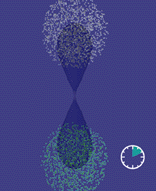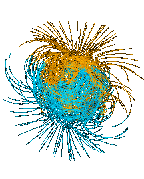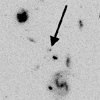![]()
![]()
 The quest
for the elusive gravity
wave may have gotten a bit easier this week. The problem with detecting gravity waves
is that it takes a cataclysmic events such as a supernova
or a collision of black holes to
produce waves that will be detectable even to the extremely sensitive 4-kilometer U.S. Laser Interferometer Gravitational-Wave
Observatory (LIGO) due to come on-line in a few years. It seems that Nils Andersson of
Washington University and Kostas Kokkotas of the Max
Planck Society Research Unit in Germany have found that gravity waves may be detected from
far more common phenomena. When gravity waves hit a neutron star, they may be
amplified by the extreme space-time
curvature caused by the incredibly massive neutron star and actually cause the star to
oscillate. However, it is still uncertain whether even the strong gravity wave source of a
supernova would be enough to cause this phenomenon. It certainly will be interesting to
see if LIGO detects any gravity waves at all when it is finally switched on in the coming
years.
The quest
for the elusive gravity
wave may have gotten a bit easier this week. The problem with detecting gravity waves
is that it takes a cataclysmic events such as a supernova
or a collision of black holes to
produce waves that will be detectable even to the extremely sensitive 4-kilometer U.S. Laser Interferometer Gravitational-Wave
Observatory (LIGO) due to come on-line in a few years. It seems that Nils Andersson of
Washington University and Kostas Kokkotas of the Max
Planck Society Research Unit in Germany have found that gravity waves may be detected from
far more common phenomena. When gravity waves hit a neutron star, they may be
amplified by the extreme space-time
curvature caused by the incredibly massive neutron star and actually cause the star to
oscillate. However, it is still uncertain whether even the strong gravity wave source of a
supernova would be enough to cause this phenomenon. It certainly will be interesting to
see if LIGO detects any gravity waves at all when it is finally switched on in the coming
years.
Related Links:
 Well, a lot has happened since I last did the the
weekly news. Evidence was found suggesting ancient
nanobacterial life on the planet Mars, Galileo continues to send back better and
better images of Jupiter and its moons, and we
found out that the Earth's core hides some surprising secrets. Since everyone knows about
the microscopic Martians, and the last weekly news I did was about Galileo, I decided to
tackle the core. In the last few months, we learned that the Earth's core may actually be
an enormous solid iron crystal the size of our moon! If this isn't enough to digest, the
Earth's core actually rotates a bit faster than the Earth itself! One extra rotation every
one hundred years as it turns out. This effectively creates a self-sustaining dynamo and
preserves the Earth's magnetic field. This motion was predicted by Gary A. Glatzmaier's
MHD (magneto-hydrodynamics) theory which he developed while modeling the magnetic field of
the sun.
Well, a lot has happened since I last did the the
weekly news. Evidence was found suggesting ancient
nanobacterial life on the planet Mars, Galileo continues to send back better and
better images of Jupiter and its moons, and we
found out that the Earth's core hides some surprising secrets. Since everyone knows about
the microscopic Martians, and the last weekly news I did was about Galileo, I decided to
tackle the core. In the last few months, we learned that the Earth's core may actually be
an enormous solid iron crystal the size of our moon! If this isn't enough to digest, the
Earth's core actually rotates a bit faster than the Earth itself! One extra rotation every
one hundred years as it turns out. This effectively creates a self-sustaining dynamo and
preserves the Earth's magnetic field. This motion was predicted by Gary A. Glatzmaier's
MHD (magneto-hydrodynamics) theory which he developed while modeling the magnetic field of
the sun.
 Well,
after a long and disappointing journey, the Galileo
spacecraft has taken a few snapshots of Jupiter's
planet-sized moon, Ganymede.
If you do not already know, the probe is crippled because it's high gain antenna failed to
open and Galileo is operating on its much more limited secondary antenna. After a hefty
software upgrade, the probe is sending back data at the screaming rate of 36 bits per
second. That's one-tenth of the speed of a 300-baud modem to you and me. If you think it
takes a long time to view a large picture on the Internet at 28800 baud, try it at 30
baud. Nevertheless, the black and white images that Galileo has managed to teletype back
are astonishingly clear due to Galileo's close flyby (less than 5,000 miles) and reveals
details that Voyager 2
missed. The folks on the Galileo team should be commended for continuing to make the best
of a disappointing situation.
Well,
after a long and disappointing journey, the Galileo
spacecraft has taken a few snapshots of Jupiter's
planet-sized moon, Ganymede.
If you do not already know, the probe is crippled because it's high gain antenna failed to
open and Galileo is operating on its much more limited secondary antenna. After a hefty
software upgrade, the probe is sending back data at the screaming rate of 36 bits per
second. That's one-tenth of the speed of a 300-baud modem to you and me. If you think it
takes a long time to view a large picture on the Internet at 28800 baud, try it at 30
baud. Nevertheless, the black and white images that Galileo has managed to teletype back
are astonishingly clear due to Galileo's close flyby (less than 5,000 miles) and reveals
details that Voyager 2
missed. The folks on the Galileo team should be commended for continuing to make the best
of a disappointing situation.
 I'll bet you thought quasars were the most distant and
mysterious objects in the deep sky? Well, it appears that might not be the case. In
studying the magnificent Hubble Deep Field images, astronomers believe that they have
found a group of galaxies even more distant than quasars. In fact, it appears that they
are so far out that we are observing them as they were when the universe was only 5% of
it's present age. It also implies
that galaxies started forming a mere few hundred million years after the Big Bang, which
is a surprise in itself. If these galaxies are indeed as distant and ancient as they seem
to be, they can provide us with unique opportunities to study the early formation of
galaxies.
I'll bet you thought quasars were the most distant and
mysterious objects in the deep sky? Well, it appears that might not be the case. In
studying the magnificent Hubble Deep Field images, astronomers believe that they have
found a group of galaxies even more distant than quasars. In fact, it appears that they
are so far out that we are observing them as they were when the universe was only 5% of
it's present age. It also implies
that galaxies started forming a mere few hundred million years after the Big Bang, which
is a surprise in itself. If these galaxies are indeed as distant and ancient as they seem
to be, they can provide us with unique opportunities to study the early formation of
galaxies.
This week news is the apparent discovery of a Sol-like solar system only 8 light years away! That's a hop, skip, and a jump in cosmological terms. The star is Lalande 21185 and it's the fourth closest to the sun. Although they have only found two Jupiter sized planets, their orbits are similar to the orbits of our own gas giants Jupiter and Saturn. This leaves open the possibility that Lalande has some closer, more Earth-like planets. Although there has been a rash of planetary discoveries lately, none have been this close or this similar to our own planetary system.
If Lalande does indeed have planets that can support life (which is rather improbable unfortunately since Lalande is a red dwarf), any intelligent life existing there has received decades of TV and radio signals from Earth. They've seen everything up till about 1988, so they have yet to see George Bush elected, the Berlin wall come down, or the rise of the Psychic Friends Network (enough to make any civilization think twice before dropping by). So if the Lalandians land in your back yard some time, be sure to tell them to prepare Lalandia II for infomercials, Rush Limbaugh, and Thigh-Masters because they are all heading for Lalande 21185 at the speed of light.
Related links:
Extra Extra!!! (added October 24th, 1996)